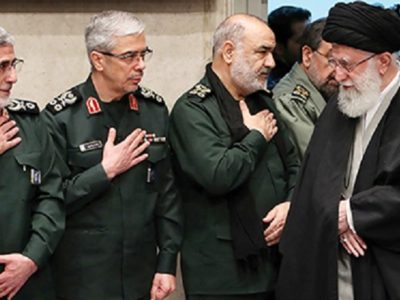The Iranian government has intensified its campaign of torture, arbitrary arrests, and detentions against political critics, Human Rights Watch said in a report released June 7, 2004. Iran’s outgoing reformist parliament in May passed legislation to prohibit torture, but without effective implementation, the law remains an empty gesture.
The 73-page report, “Like the Dead in Their Coffins: Torture, Detention, and the Crushing of Dissent in Iran,” provides the first comprehensive account of the treatment of political detainees in Tehran’s Evin Prison and in secret prisons around the capital since the government launched its current crackdown in 2000. Human Rights Watch has documented systematic abuses against political detainees, including arbitrary arrest, detention without trial, torture to extract confessions, prolonged solitary confinement, and physical and psychological abuse.
“Claims that reforms in Iran have put an end to torture are simply false,” said Sarah Leah Whitson, executive director of Human Rights Watch’s Middle East and North Africa Division. “More than ever, journalists, intellectuals and activists are afraid to voice opinions critical of the government.”
The Iranian government’s use of these harsh techniques has largely squelched the country’s political opposition and independent media. Faced with increasing political pressure for reform in the past four years, the government has intensified its campaign against dissent. As of June, the government has closed virtually all independent newspapers, several key journalists and writers have fled the country, many prominent writers and activists have been imprisoned, and scores of student activists have been intimidated into ending their involvement in peaceful political activity.
While newspaper closures in Iran have received wide media attention, the story of the abuses that journalists, intellectuals and protestors have endured in detention has never been fully told.
The report documents the systematic use of prolonged solitary confinement as a tool to break the will of dissidents, and as a means to extract forced confessions. Individuals interviewed for the report, including a number of writers and journalists, told Human Rights Watch about brutal interrogations in which they were blindfolded, physically threatened, and forced to recant their political views. Former detainees also described basement solitary cells where they were left for weeks at a time without any human contact, and threats by judges that if they did not confess, they would be held in solitary confinement indefinitely.
Student activists told Human Rights Watch about physical torture experienced at the hands of plainclothes security and intelligence agents. The report documents cases of beatings, long confinement in contorted positions, kicking detainees with military boots, hanging detainees by the arms and legs, and threats of execution if individuals refused to confess.
The report also describes in detail the plainclothes intelligence agencies that work for the judiciary and are directly responsible for detaining and torturing those who criticize the government. These agencies often operate outside of, or parallel to, the established administrative structure of government and report directly to Iran’s religious leadership. The members of these “parallel forces,” whom former detainees describe as foot soldiers in the campaign against dissent, have not been held accountable for their acts.
Human Rights Watch documented the participation of judges in interrogation rooms—often in secret prisons—overseeing abusive and coercive interrogations, interceding with detainees and urging them to sign false confessions, and even issuing threats of their own. A number of judicial authorities, especially Chief Prosecutor Said Mortazavi, have blatantly abandoned their duty to fairly administer justice and instead are known for ordering the torture of political detainees.
A number of former detainees reported that they were treated more harshly after requesting the aid of defense counsel, or inquiring as to the legal status of their cases.
The report called on the European Union to increase pressure on Iran to take strong steps to end torture and ill-treatment in detention and restore freedom of expression. The ongoing EU-Iran human rights dialogue will have its next meeting in Tehran on June 14 and 15. The dialogue, entering its third year, has failed to achieve any tangible results. In fact, the human rights situation in Iran has markedly deteriorated since the inception of the dialogue.
“The European Union’s weak response to continuing human rights violations in Iran is deeply disturbing,” said Whitson, “It’s time for the European Union to condemn Iran’s record of persecution and torture and to set real benchmarks that the government must meet.”
Human Rights Watch called on the Iranian government to release all political prisoners and effectively prohibit torture immediately.
—————
Background
The current crackdown began in April 2000 after Supreme Leader Ayatollah Khamenei gave a speech targeting the independent press for being a “stronghold for the enemy.” In 2002 and 2003, the Iranian government turned the focus of its repression on political activists. It responded to a series of student protests across Iran with several thousand arrests. The government’s campaign of repression fed on itself: as more and more newspapers were closed down, there were fewer and fewer avenues to publicize abuses by the government. The rapid decline in publicly available information about the government’s practices gave Iranian authorities an even freer hand to engage in abuse, and the government took full advantage of the lack of scrutiny.
Testimonies from “Like the Dead in Their Coffins”
Hossein T., an Iranian university student and activist
Twice they took me to the courtyard in Evin, where the executions are carried out. They tied my feet. They took off my blindfold. One man was saying: “Tell me why you lied. Tell me what you did.” They hung me from my feet, and they put a bag over my head. For what I think was 30 minutes, they were kicking me and hitting me. They hit my chin, and the skin broke. Blood began to fill the bag that was tied over my head. Blood began to drip on the floor, and this is when they stopped.
The second time they took me in there, they hung me from my hands. They used a baton to beat my torso. They broke my hand, and I fell unconscious. When I regained consciousness, they said, “If you say you lied, we will stop.” I could not speak. It is not because I am brave that I did not confess, it is because I couldn’t talk.
Massoud B., an Iranian journalist and writer
In the first few hours, it is very hard. You have never been this close to walls in your life. You don’t want to sit, because it is chalk, and you are not used to sitting on chalk. You stand. You pace. You start to get dizzy. After you get dizzy, you lean on a wall. After three or four hours, your legs get tired, and you sit. And then you scream and no one hears you.
And you feel like they are holding you, like they are physically holding on to you. Your hair and nails grow faster. A lot of prisoners say that solitary is like being like “the dead in their coffins” because we had heard that the dead’s nails grow in their coffins. Even if they had given me something to read, they had taken my glasses. Even if I had had my glasses, there wasn’t enough light.
http://www.hrw.org/en/news/2004/06/06/iran-torture-used-suppress-dissent








